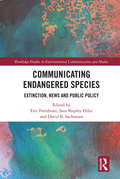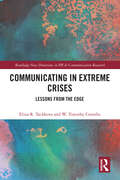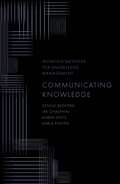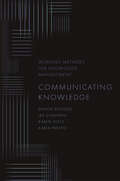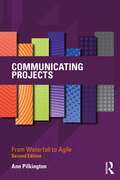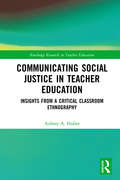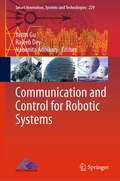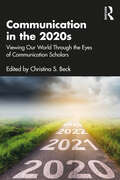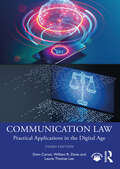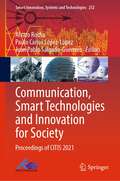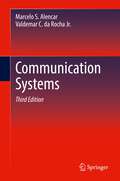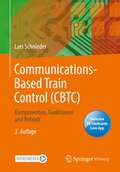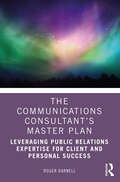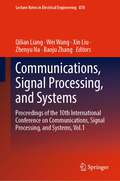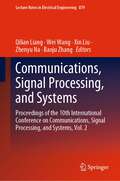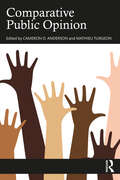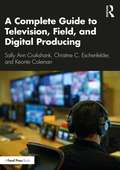- Table View
- List View
Communicating Endangered Species: Extinction, News and Public Policy (Routledge Studies in Environmental Communication and Media)
by Eric Freedman Sara Shipley Hiles David B. SachsmanCommunicating Endangered Species: Extinction, News, and Public Policy is a multidisciplinary environmental communication book that takes a distinctive approach by connecting how media and culture depict and explain endangered species with how policymakers and natural resource managers can or do respond to these challenges in practical terms. Extinction isn’t new. However, the pace of extinction is accelerating globally. The International Union for Conservation of Nature classifies more than 26,000 species as threatened. The causes are many, including climate change, overdevelopment, human exploitation, disease, overhunting, habitat destruction, and predators. The willingness and the ability of ordinary people, governments, scientists, nongovernmental organizations, and businesses to slow this deeply disturbing acceleration are uncertain. Meanwhile, researchers around the world are laboring to better understand and communicate the possibility and implications of extinctions and to discover effective tools and public policies to combat the threats to species survival. This book presents a history of news coverage of endangered species around the world, examining how and why journalists and other communicators wrote what they did, how attitudes have changed, and why they have changed. It draws on the latest research by chapter authors who are a mix of social scientists, communication experts, and natural scientists. Each chapter includes a mass media and/or cultural aspect. This book will be essential reading for students, natural resource managers, government officials, environmental activists, and academics interested in conservation and biodiversity, environmental communication and journalism, and public policy.
Communicating in Extreme Crises: Lessons from the Edge (Routledge New Directions in PR & Communication Research)
by Elina Tachkova W. Timothy CoombsThis book is an evidence-based approach to handling common, extreme crises. Extreme crises involve strong moral outrage; moral outrage creates situations where traditional crisis communication advice no longer is effective. These extreme crises create unique demands for crisis managers. Moreover, much of the traditional advice and crisis key performance indicators (KPIs) no longer apply. Validated through research, the book establishes the nature of extreme crises, the optimal crisis response for such crises, and the KPIs (outcomes) crisis managers need to measure for extreme crises. It serves as a guide for how to communicate effectively during extreme crises and provides advice based upon experimental research that validates the effectiveness of the crisis communication interventions. Readers do not require prior knowledge about crisis communication and crisis management as the book contains summaries of crisis communication and management before exploring the more specialized topic of extreme crises. Chapters include extended case studies, examining communication within such events as the Westpac money laundering, VW emissions and COVID-19 crises. Communications in Extreme Crises will be of direct interest to scholars of crisis communication in public relations, corporate communication, strategic communication, organizational communication programs and management.
Communicating in Extreme Crises: Lessons from the Edge (Routledge New Directions in PR & Communication Research)
by Elina Tachkova W. Timothy CoombsThis book is an evidence-based approach to handling common, extreme crises. Extreme crises involve strong moral outrage; moral outrage creates situations where traditional crisis communication advice no longer is effective. These extreme crises create unique demands for crisis managers. Moreover, much of the traditional advice and crisis key performance indicators (KPIs) no longer apply. Validated through research, the book establishes the nature of extreme crises, the optimal crisis response for such crises, and the KPIs (outcomes) crisis managers need to measure for extreme crises. It serves as a guide for how to communicate effectively during extreme crises and provides advice based upon experimental research that validates the effectiveness of the crisis communication interventions. Readers do not require prior knowledge about crisis communication and crisis management as the book contains summaries of crisis communication and management before exploring the more specialized topic of extreme crises. Chapters include extended case studies, examining communication within such events as the Westpac money laundering, VW emissions and COVID-19 crises. Communications in Extreme Crises will be of direct interest to scholars of crisis communication in public relations, corporate communication, strategic communication, organizational communication programs and management.
Communicating Knowledge (Working Methods for Knowledge Management)
by Denise Bedford Ira Chalphin Karen Dietz Karla PhlypoThe communication of knowledge is a core concept in the field of knowledge management and an essential new role and responsibility of business managers. Knowledge capital is the primary source of wealth and the key source of productivity in the knowledge economy. Stockpiling and storing knowledge diminishes its value. It is only through circulation that our knowledge capital realizes its business value. Communicating Knowledge addresses essential management practices in the 21st-century knowledge economy. It speaks to the change that every organization is experiencing as they transition from an industrial to a knowledge organization. The COVID-19 pandemic has heightened an awareness of communications practices in the past year, with communication norms and behaviors being challenged at every level. How we communicate, when we communicate, with whom we communicate, and what we communicate is currently undergoing a global reform. Communication competencies are no longer desirable qualities in managers - they are essential. This book is intended for business managers working at all levels, knowledge management practitioners and scholars, communications professionals, practitioners, and consultants.
Communicating Knowledge (Working Methods for Knowledge Management)
by Denise Bedford Ira Chalphin Karen Dietz Karla PhlypoThe communication of knowledge is a core concept in the field of knowledge management and an essential new role and responsibility of business managers. Knowledge capital is the primary source of wealth and the key source of productivity in the knowledge economy. Stockpiling and storing knowledge diminishes its value. It is only through circulation that our knowledge capital realizes its business value. Communicating Knowledge addresses essential management practices in the 21st-century knowledge economy. It speaks to the change that every organization is experiencing as they transition from an industrial to a knowledge organization. The COVID-19 pandemic has heightened an awareness of communications practices in the past year, with communication norms and behaviors being challenged at every level. How we communicate, when we communicate, with whom we communicate, and what we communicate is currently undergoing a global reform. Communication competencies are no longer desirable qualities in managers - they are essential. This book is intended for business managers working at all levels, knowledge management practitioners and scholars, communications professionals, practitioners, and consultants.
Communicating Projects: From Waterfall to Agile
by Ann PilkingtonThe communication of projects to each stakeholder group is essential to their success. This book is an end-to-end guide for project managers and communication teams seeking to communicate effectively with all constituents, both internal and external. This new edition includes a number of key topical themes that build on the first edition: An introduction to project management for those new to the field, including communicating "agile", as many communication practitioners and project managers find themselves having to communicate in an agile environment, which has a language all of its own. The important role of social media and enterprise social networks as vital communication channels. The principles of change management. The role of storytelling and the importance of translating technical terminology and data into stories that clients and the wider stakeholder groups understand. Crisis communication – ensuring there is a crisis or emergency communication process in place in case it is ever needed. This highly practical book is invaluable reading for communication professionals who are increasingly managing the communication elements of projects. It also supports project managers who need to gain a practical understanding of how to design and deliver communication, as well as helping them to procure effective communication support.
Communicating Projects: From Waterfall to Agile
by Ann PilkingtonThe communication of projects to each stakeholder group is essential to their success. This book is an end-to-end guide for project managers and communication teams seeking to communicate effectively with all constituents, both internal and external. This new edition includes a number of key topical themes that build on the first edition: An introduction to project management for those new to the field, including communicating "agile", as many communication practitioners and project managers find themselves having to communicate in an agile environment, which has a language all of its own. The important role of social media and enterprise social networks as vital communication channels. The principles of change management. The role of storytelling and the importance of translating technical terminology and data into stories that clients and the wider stakeholder groups understand. Crisis communication – ensuring there is a crisis or emergency communication process in place in case it is ever needed. This highly practical book is invaluable reading for communication professionals who are increasingly managing the communication elements of projects. It also supports project managers who need to gain a practical understanding of how to design and deliver communication, as well as helping them to procure effective communication support.
Communicating Social Justice in Teacher Education: Insights from a Critical Classroom Ethnography (Routledge Research in Teacher Education)
by Aubrey A. HuberEvolving out of ethnographic fieldwork, this text examines how ideas of social justice are articulated and communicated by pre-service teachers and graduate teaching assistants in the US. By positing the concept of "help" as a central tenet of social justice within teacher education, this volume offers a unique performative analysis of how the concept is communicatively constituted in teacher education and training. Using a social justice framework, the book examines the ways in which new teachers contend with their identities as educators, and demonstrates how these communicative performances influence pre-service and new teachers’ perceptions of their role, as well as their responsibility to engage with social justice and critical approaches in the classroom. This text will benefit researchers, academics, and educators in higher education with an interest in teacher education, critical communication studies, and the sociology of education more broadly. Those specifically interested in teacher training, mentoring, and social justice in the classroom will also benefit from this book.
Communicating Social Justice in Teacher Education: Insights from a Critical Classroom Ethnography (Routledge Research in Teacher Education)
by Aubrey A. HuberEvolving out of ethnographic fieldwork, this text examines how ideas of social justice are articulated and communicated by pre-service teachers and graduate teaching assistants in the US. By positing the concept of "help" as a central tenet of social justice within teacher education, this volume offers a unique performative analysis of how the concept is communicatively constituted in teacher education and training. Using a social justice framework, the book examines the ways in which new teachers contend with their identities as educators, and demonstrates how these communicative performances influence pre-service and new teachers’ perceptions of their role, as well as their responsibility to engage with social justice and critical approaches in the classroom. This text will benefit researchers, academics, and educators in higher education with an interest in teacher education, critical communication studies, and the sociology of education more broadly. Those specifically interested in teacher training, mentoring, and social justice in the classroom will also benefit from this book.
Communication and Control for Robotic Systems (Smart Innovation, Systems and Technologies #229)
by Jason Gu Rajeeb Dey Nabanita AdhikaryThis book is a collection of high-quality research articles. The book includes topics specific to the emerging areas of control for robotic systems, wireless communication, and development of embedded systems for robotic applications. The book integrates three important aspects of automation, namely (i) communication, (ii) control, and (iii) embedded design for robotic applications. This book is unique as it provides a unified framework for analysis, design, and deployment of the robotic applications across various engineering and non-engineering disciplines including the three primary aspects mentioned above. Furthermore, the emerging research and development work pertaining to the deployment of intelligent, nonlinear, and embedded control for robotic system for non-standard operating environment due to the widespread application of robotics technology for societal benefit is also a focal point of the book.
Communication in the 2020s: Viewing Our World Through the Eyes of Communication Scholars
by Christina S. BeckThis book provides an inside look at the discipline of Communication. In this collection of chapters, top scholars from a wide range of subfields discuss how they have experienced and how they study the crucial issues of our time. The 2020s opened with a series of events with massive implications for the ways we communicate, from the COVID-19 pandemic, a summer of protests for social justice, and climate change-related natural disasters, to one of the most contentious presidential elections in modern U.S. history. The chapters in this book provide snapshots of many of these issues as seen through the eyes of specialists in the major subfields of Communication, including interpersonal, organizational, strategic, environmental, religious, social justice, risk, sport, health, family, instructional, and political communication. Written in an informal style that blends personal narrative with accessible explanation of basic concepts, the book is ideal for introducing students to the range and practical applications of Communication discipline. This book comprises a valuable companion text for Introduction to Communication courses as well as a primary resource for Capstone and Introduction to Graduate Studies courses. Further, this collection provides meaningful insights for Communication scholars as we look ahead to the remainder of the 2020s and beyond.
Communication in the 2020s: Viewing Our World Through the Eyes of Communication Scholars
by Christina S. BeckThis book provides an inside look at the discipline of Communication. In this collection of chapters, top scholars from a wide range of subfields discuss how they have experienced and how they study the crucial issues of our time. The 2020s opened with a series of events with massive implications for the ways we communicate, from the COVID-19 pandemic, a summer of protests for social justice, and climate change-related natural disasters, to one of the most contentious presidential elections in modern U.S. history. The chapters in this book provide snapshots of many of these issues as seen through the eyes of specialists in the major subfields of Communication, including interpersonal, organizational, strategic, environmental, religious, social justice, risk, sport, health, family, instructional, and political communication. Written in an informal style that blends personal narrative with accessible explanation of basic concepts, the book is ideal for introducing students to the range and practical applications of Communication discipline. This book comprises a valuable companion text for Introduction to Communication courses as well as a primary resource for Capstone and Introduction to Graduate Studies courses. Further, this collection provides meaningful insights for Communication scholars as we look ahead to the remainder of the 2020s and beyond.
Communication Law: Practical Applications in the Digital Age
by Dom Caristi William R Davie Laurie Thomas LeeThis fully revised third edition brings a fresh approach to the fundamentals of mass media and communication law in a presentation that undergraduate students find engaging and accessible. Designed for students of communication that are new to law, this volume presents key principles and emphasizes the impact of timely, landmark cases on today’s media world, providing an applied learning experience. This new edition offers expanded coverage of digital media law and social media, a wealth of new case studies, expanded discussions of current political, social, and cultural issues, and new features focused on ethical considerations and on international comparative law. Communication Law serves as a core textbook for undergraduate courses in communication and mass media law. Online resources for instructors, including an Instructor’s Manual, Test Bank, and PowerPoint slides, are available at: www.routledge.com/9780367546694
Communication Law: Practical Applications in the Digital Age
by Dom Caristi William R Davie Laurie Thomas LeeThis fully revised third edition brings a fresh approach to the fundamentals of mass media and communication law in a presentation that undergraduate students find engaging and accessible. Designed for students of communication that are new to law, this volume presents key principles and emphasizes the impact of timely, landmark cases on today’s media world, providing an applied learning experience. This new edition offers expanded coverage of digital media law and social media, a wealth of new case studies, expanded discussions of current political, social, and cultural issues, and new features focused on ethical considerations and on international comparative law. Communication Law serves as a core textbook for undergraduate courses in communication and mass media law. Online resources for instructors, including an Instructor’s Manual, Test Bank, and PowerPoint slides, are available at: www.routledge.com/9780367546694
Communication, Smart Technologies and Innovation for Society: Proceedings of CITIS 2021 (Smart Innovation, Systems and Technologies #252)
by Álvaro Rocha Paulo Carlos López-López Juan Pablo Salgado-GuerreroThis book gathers high-quality papers presented at International Conference on Science, Technology and Innovation for Society (CITIS 2021), held in Guayaquil, Ecuador, on May 26–28, 2021. This book will present the recent research trends in the fields of software engineering, big data analysis, cloud computing, data engineering, data management and data mining, machine learning, deep learning, artificial intelligence, smart systems, robotics and automation, mechatronic design, and industrial processes design.
Communication Systems
by Marcelo S. Alencar Valdemar C. da Rocha Jr.Presents main concepts of mobile communication systems, both analog and digital Introduces concepts of probability, random variables and stochastic processes and their applications to the analysis of linear systems Includes five appendices covering Fourier series and transforms, GSM cellular systems and more
Communications-Based Train Control (CBTC): Komponenten, Funktionen und Betrieb
by Lars SchniederInnerstädtische Schienenverkehrssysteme stoßen bei steigender Verkehrsnachfrage zunehmend an ihre Grenzen. Die Sicherheit und die Leistungsfähigkeit dieser Verkehrssysteme werden wesentlich durch die eingesetzte Leit- und Sicherungstechnik bestimmt. Eine Ausweitung des Verkehrsangebots erfordert leistungsfähige signaltechnische Systeme, die als Communications-Based Train Control Systeme (CBTC) bezeichnet werden. In diesem Buch stellt der Autor die Systemumgebung dar, in die sich die CBTC-Systeme in Nahverkehrsunternehmen integrieren. Es wird gezeigt, welchen Beitrag die einzelnen Sicherungsfunktionen von CBTC-Lösungen zur Gefährdungsbeherrschung leisten und wie technische Systeme mit zunehmender Automatisierung sukzessive mehr Funktionen vom Menschen übernehmen. Zum Abschluss werden an CBTC-Systeme gestellte nicht-funktionale Anforderungen wie Sicherheit, Verfügbarkeit, Leistungsfähigkeit und Wirtschaftlichkeit diskutiert und Faktoren einer erfolgreichen Abwicklung komplexer signaltechnischer Erneuerungsprojekte aufgezeigt.Zusätzliche Fragen per App: Laden Sie die Springer Nature Flashcards-App kostenlos herunter und nutzen Sie exklusives Zusatzmaterial, um Ihr Wissen zu prüfen.
The Communications Consultant’s Master Plan: Leveraging Public Relations Expertise for Client and Personal Success
by Roger DarnellThis volume builds on Roger Darnell’s The Communications Consultant’s Foundation by providing insider knowledge gained over the past three decades atop the field of communications consulting, incorporating lessons learned serving businesses in the global creative industry. Going beyond the basics of a communications consulting business, this book parses and distills the knowledge of top business management luminaries, helping readers build and expand their expertise to heighten their opportunities, and maximize all aspects and phases of their businesses, from start-up through to succession. It discusses essential topics including: • The business of running a PR agency, with emphasis on landing clients and honing expertise to remain exceptional • Advanced PR practices including investor relations and strategic planning • Agency expansion, addressing growth and exit strategies Working PR professionals, entrepreneurs, students, and recent graduates will appreciate high-level insights from a seasoned business owner, as well as templates for proposals, campaign planning, and more. Read with The Communications Consultant’s Foundation or on its own, this book will lead readers on life-changing journeys and help a new generation of smart communicators take their professional pursuits to the highest levels.
The Communications Consultant’s Master Plan: Leveraging Public Relations Expertise for Client and Personal Success
by Roger DarnellThis volume builds on Roger Darnell’s The Communications Consultant’s Foundation by providing insider knowledge gained over the past three decades atop the field of communications consulting, incorporating lessons learned serving businesses in the global creative industry. Going beyond the basics of a communications consulting business, this book parses and distills the knowledge of top business management luminaries, helping readers build and expand their expertise to heighten their opportunities, and maximize all aspects and phases of their businesses, from start-up through to succession. It discusses essential topics including: • The business of running a PR agency, with emphasis on landing clients and honing expertise to remain exceptional • Advanced PR practices including investor relations and strategic planning • Agency expansion, addressing growth and exit strategies Working PR professionals, entrepreneurs, students, and recent graduates will appreciate high-level insights from a seasoned business owner, as well as templates for proposals, campaign planning, and more. Read with The Communications Consultant’s Foundation or on its own, this book will lead readers on life-changing journeys and help a new generation of smart communicators take their professional pursuits to the highest levels.
Communications, Signal Processing, and Systems: Proceedings of the 10th International Conference on Communications, Signal Processing, and Systems, Vol.1 (Lecture Notes in Electrical Engineering #878)
by Qilian Liang Wei Wang Xin Liu Zhenyu Na Baoju ZhangThis book brings together papers presented at the 2021 International Conference on Communications, Signal Processing, and Systems, which provides a venue to disseminate the latest developments and to discuss the interactions and links between these multidisciplinary fields. Spanning topics ranging from communications, signal processing and systems, this book is aimed at undergraduate and graduate students in Electrical Engineering, Computer Science and Mathematics, researchers and engineers from academia and industry as well as government employees (such as NSF, DOD and DOE).
Communications, Signal Processing, and Systems: Proceedings of the 10th International Conference on Communications, Signal Processing, and Systems, Vol. 2 (Lecture Notes in Electrical Engineering #879)
by Qilian Liang Wei Wang Xin Liu Zhenyu Na Baoju ZhangThis book brings together papers presented at the 2021 International Conference on Communications, Signal Processing, and Systems, which provides a venue to disseminate the latest developments and to discuss the interactions and links between these multidisciplinary fields. Spanning topics ranging from communications, signal processing and systems, this book is aimed at undergraduate and graduate students in Electrical Engineering, Computer Science and Mathematics, researchers and engineers from academia and industry as well as government employees (such as NSF, DOD and DOE).
Comparative Public Opinion
by Cameron D. Anderson Mathieu TurgeonThis book presents a comprehensive examination of public opinion in the democratic world. Built around chapters that highlight key explanatory frameworks used in understanding public opinion, the book presents a coherent study of the subject in a comparative perspective, emphasizing and interrogating immigration as a key issue of high concern to most mass publics in the democratic world. Key features of the book include: Covers several theoretical issues and determinants of opinion such as the effects of personality, age and life cycle, ideology, social class, partisanship, gender, religion, ethnicity, language, and media, highlighting over time the effects of political, social, and economic contexts. Each chapter explores the theoretical rationale, mechanisms of effect, and use in the scholarly literature on public opinion before applying these to the issue of immigration comparatively and in specific places or regions. Widely comparative using a nine-country sample (Australia, Canada, France, Germany, Italy, Portugal, Switzerland, the United Kingdom, and the United States of America) in the analysis of individual-level determinants of public opinion about immigration and extending to other countries like Belgium, Brazil, and Japan when evaluating contextual factors. This edited volume will be essential reading for students, scholars, and practitioners interested in public opinion, political behaviour, voting behaviour, politics of the media, immigration, political communication, and, more generally, democracy and comparative politics.
Comparative Public Opinion
by Cameron D. Anderson and Mathieu TurgeonThis book presents a comprehensive examination of public opinion in the democratic world. Built around chapters that highlight key explanatory frameworks used in understanding public opinion, the book presents a coherent study of the subject in a comparative perspective, emphasizing and interrogating immigration as a key issue of high concern to most mass publics in the democratic world. Key features of the book include: Covers several theoretical issues and determinants of opinion such as the effects of personality, age and life cycle, ideology, social class, partisanship, gender, religion, ethnicity, language, and media, highlighting over time the effects of political, social, and economic contexts. Each chapter explores the theoretical rationale, mechanisms of effect, and use in the scholarly literature on public opinion before applying these to the issue of immigration comparatively and in specific places or regions. Widely comparative using a nine-country sample (Australia, Canada, France, Germany, Italy, Portugal, Switzerland, the United Kingdom, and the United States of America) in the analysis of individual-level determinants of public opinion about immigration and extending to other countries like Belgium, Brazil, and Japan when evaluating contextual factors. This edited volume will be essential reading for students, scholars, and practitioners interested in public opinion, political behaviour, voting behaviour, politics of the media, immigration, political communication, and, more generally, democracy and comparative politics.
A Complete Guide to Television, Field, and Digital Producing
by Sally Ann Cruikshank Christine C. Eschenfelder Keonte ColemanThis book provides an extensive overview of producing in the ever-changing field of journalism for all types of newsrooms. Featuring interviews with renowned journalism professionals, A Complete Guide to Television, Field, and Digital Producing offers an in-depth look at the broadcast, field, and digital producing practices of newsrooms today. The book is divided into three parts: television news producing, field producing, and digital producing. Each part provides a clear explanation of the producing role before going into more detail on important skills such as developing stories, writing copy, creating graphics, producing live on location, audience engagement, and using social media. Each chapter includes a variety of supplemental material, including discussion questions, keyword definitions, classroom activities, and graded assignments, including rubrics. Written with a combined 64 years of journalism and journalism education experience, the book will prepare students to produce whatever their job requires. Taking an integrated approach to journalism education, this is a vital text for journalism and media students studying digital media, broadcast journalism, social media, and reporting.
A Complete Guide to Television, Field, and Digital Producing
by Sally Ann Cruikshank Christine C. Eschenfelder Keonte ColemanThis book provides an extensive overview of producing in the ever-changing field of journalism for all types of newsrooms. Featuring interviews with renowned journalism professionals, A Complete Guide to Television, Field, and Digital Producing offers an in-depth look at the broadcast, field, and digital producing practices of newsrooms today. The book is divided into three parts: television news producing, field producing, and digital producing. Each part provides a clear explanation of the producing role before going into more detail on important skills such as developing stories, writing copy, creating graphics, producing live on location, audience engagement, and using social media. Each chapter includes a variety of supplemental material, including discussion questions, keyword definitions, classroom activities, and graded assignments, including rubrics. Written with a combined 64 years of journalism and journalism education experience, the book will prepare students to produce whatever their job requires. Taking an integrated approach to journalism education, this is a vital text for journalism and media students studying digital media, broadcast journalism, social media, and reporting.
